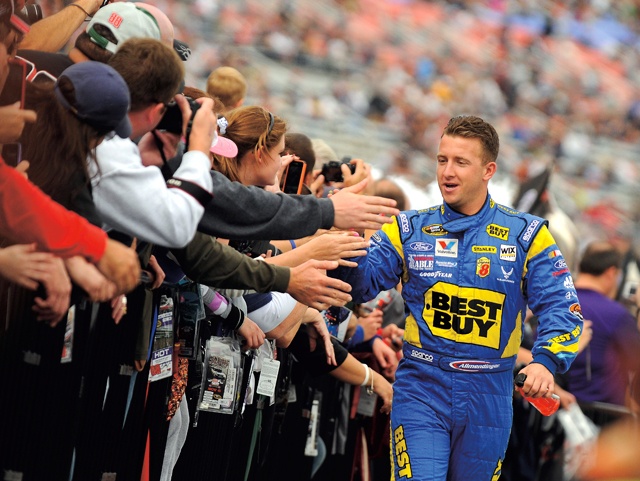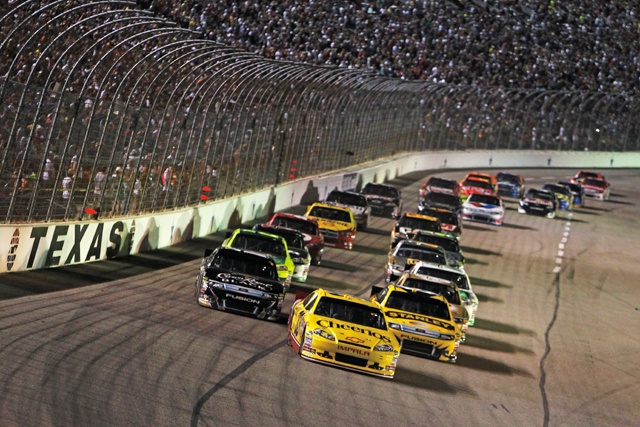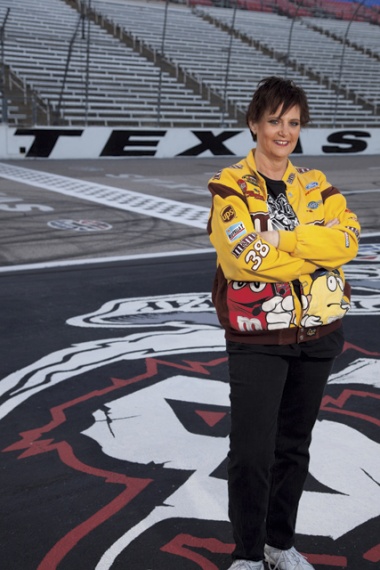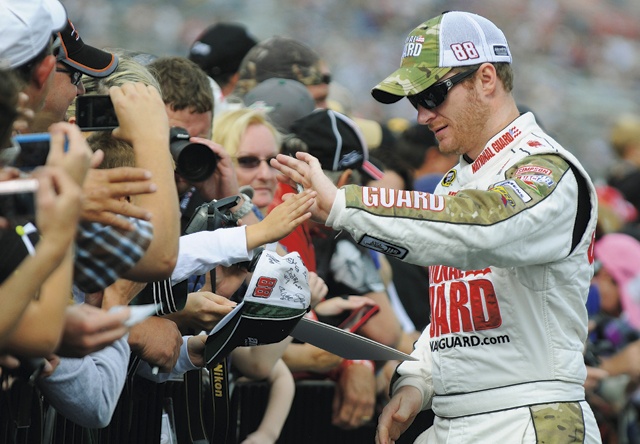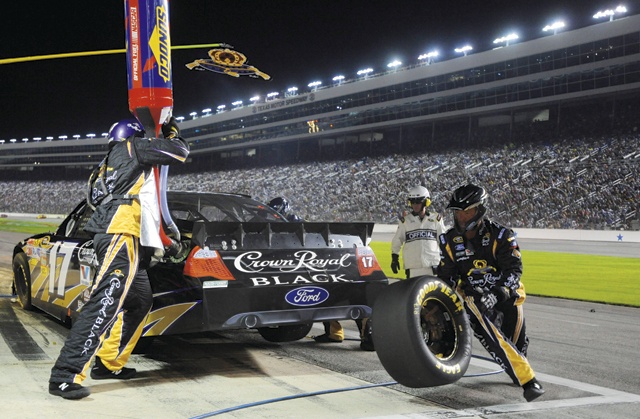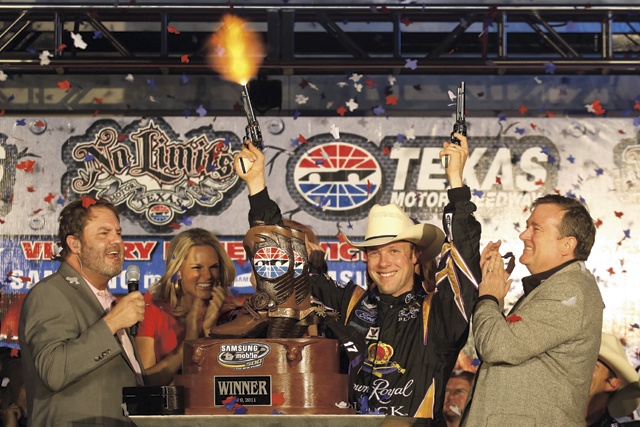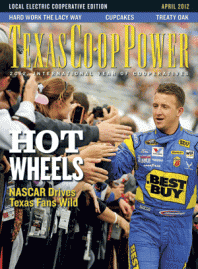It was the smell. Unmistakable. Gasoline.
And the sound. Startling. An explosion.
But not just one explosion. Forty-three all at once—in the bellies of 43 race cars—that made then 40-year-old Marina Kerr fall in love on a sunny afternoon in April 2003.
“So in love,” she said.
Kerr, now 49, was at her first NASCAR race. She didn’t know much about auto racing. But that was OK. She liked cars, and the enormous track of Texas Motor Speedway, off Interstate 35 West between Fort Worth and Denton, was filled with them.
“When I was 13, 14, 15, and my girlfriends were out at the mall buying makeup, I was over at my brothers’ best friend’s house with my head under the hood of a ’69 Chevelle SS Super Sport, and I’ve been crazy about cars ever since,” she says.
But up until that day at her first race, in the seconds before the start, before the traditional command—“Gentlemen, start your engines!”—she didn’t know how crazy.
“The first time I came out, they were still running leaded gasoline in the cars,” she said. “And when they cranked up those 43 motors and the smell of that gasoline … I was in love. I was so in love.”
America’s No. 1 Spectator Sport
More people than Marina Kerr of Grand Prairie have been smitten by Texas Motor Speedway. The mile-and-a-half track, encircling an infield so big that four Cowboys Stadiums (home of the Dallas Cowboys) could fit inside it, is big and loud and alive on race day.
A typical race weekend looks like this: NASCAR fans, on the scene for days now, fill the infield with tents, RVs and flags with the numbers of their favorite drivers flying. Souvenir stands sell shirts, jackets, headphones, Christmas ornaments—anything with a driver or a sponsor logo. Crowds mill and gather around pit road and the garage, snapping pictures, hunting autographs and watching the crews make final race-car preparations (the cars now run on a 15-percent ethanol blend fuel).
At the start/finish line, Willie Nelson, Trace Adkins, Foreigner and ZZ Top have all put their tunes to warm-up duty for the crowd. Motorcycle daredevil/stuntman Robbie Knievel, son of the late Evel Knievel, has jumped cars and buses at the start/finish line.
But it’s not only Texas Motor Speedway that buzzes. All 26 of the nation’s official NASCAR tracks offer the same festival feel. NASCAR is the No. 1 spectator sport in America, averaging close to 100,000 fans a race, and it has more of the top-20 attended events than any other sport in the United States. On TV, it is the nation’s No. 2-rated regular-season sport, behind the NFL.
NASCAR fans drive all over the country to get to a race, taking their RVs or motor homes or sometimes just their pickup trucks. They camp inside the track. They camp outside the track. They come early, and when the race is over, they pack up and begin the trip back home, or to the next race.
It’s a family vacation for some, an annual tradition for others. For many, it’s a requirement of sorts, necessary to fill a latent need for speed, especially in a state like Texas with wide-open spaces and a seemingly endless expanse of highways. Fittingly, perhaps, Texas provides a huge fan base and one of the biggest and fastest tracks on the series.
And every April, the fans and the best teams and drivers converge for the biggest sporting event in Texas, based on attendance: a weekend of racing that culminates with the Samsung Mobile 500, one of 36 races in NASCAR’s annual, points-based Sprint Cup Series.
During three days of racing this spring, April 12-14, Texas Motor Speedway officials expect 400,000 fans—the usual crowd—to pack the infield and grandstands in anticipation of the grand finale: the Samsung Mobile 500 in which big-name drivers such as Tony Stewart, Carl Edwards and Dale Earnhardt Jr. are scheduled to compete.
The scene, on a slightly smaller scale, will repeat November 1-4 with the NASCAR Camping World Truck Series and Nationwide Series races and another Sprint Cup Series race: the AAA Texas 500, which is the eighth of 10 races in the Chase for the Cup that culminates the Sprint Cup Series and determines its champion.
And every June, the track welcomes the IZOD IndyCar Series, the country’s top open-wheel racing series.
Those are just the biggies. There’s a dirt track, too. Bring-your-own-street-car drag races on Friday nights in the summer. The Texas Motorsports Hall of Fame. Banquet rooms for proms and weddings. Condos off Turn 2. The NASCAR Sprint Cup Driving School. And the NASCAR Racing Experience in which fans can drive a real racecar around the track.
Texas Motor Speedway is a poster child for the hit that NASCAR racing has become in this state in the track’s 17 years in North Texas.
“Every type of person you can imagine is out here,” said Troy Bagwell of Decatur, a first-time visitor to the track in November for the AAA Texas 500. “It’s really cool.”
Dallas Cowboys … and NASCAR
The fans come mainly from Texas, of course. But Texas Motor Speedway President Eddie Gossage says the track has season-ticket holders in all 50 states. The sagging economy has dragged down Texas Motor Speedway’s attendance numbers to about 150,000 for the most recent Sprint Cup races, the headline attraction. But in recent years, the track has drawn as many as 216,000 fans for one day of Samsung Mobile 500 racing.
“I never would have expected it,” Kerr said last November at the AAA Texas 500, sitting with a book in a lawn chair, shaded by her RV that’s been parked in the infield at Texas Motor Speedway for a couple of days now. She’s been to every NASCAR race at Texas Motor Speedway except two or three, she figures. And over the years, she’s gotten to know many of the people who park near her in the infield.
Kerr doesn’t give the stereotypical impression of the rowdy race fan. No old shirt, no beer can. She could be running a PTA meeting. But she knows what a winning car ought to sound like. Yet when she looks around at the grandstands surrounding her like the walls of a canyon, and she sees them filling up, it still surprises her a little. It’s an awful lot of people for a car race.
Why? Well, this is Texas, after all. “Texans aren’t about cars,” Kerr said. “They’re about football. They’re about the Dallas Cowboys, you know? Of course, right now, they’re about the Texas Rangers because we made it to the World Series. But in this part of the world, anyway, the Dallas Cowboys rule. And for NASCAR to have become this big, it’s just amazing.”
Kerr represents a growing trend: About 40 percent of NACAR’s fan base is female. And kids are everywhere, too. Here at Texas Motor Speedway, they’re carrying around bags full of goodies and souvenirs, toting autograph books and pens as if they were looking for Mickey at Walt Disney World.
The Texas track, and many others like it around the country, promotes a family environment. Outside the grandstands, the area between Turn 4 and Turn 1 becomes a midway with games for kids, car exhibits, souvenir stands and racing arcades. Fans can munch on a funnel cake and get their picture taken in a replica of Edwards’ Sprint Cup car.
“My daughter got us started in this years ago,” said Glynn Timmerman of Arlington, who walked the midway at the November race with his family and 11-year-old daughter, who had discovered NASCAR at the age of 3. “She got me and her mama years ago by watching it on TV … She just sat there in front of the TV watching Tony Stewart going around and around in circles. She got us all hooked doing it that way.”
Texas Speed, Texas Money
On November 28, 1994, Bruton Smith, owner of seven tracks that hosted NASCAR races, announced he was building an eighth, and that it would be in Texas.
The choice for the site was the Alliance Corridor, a growing business area north of Fort Worth with plenty of open space. Five months later, on April 11, 1995, NASCAR drivers Bobby and Terry Labonte, Texas-born brothers, and Sprint Cup champion Jeff Gordon helped break ground on Texas Motor Speedway at the northeast corner of the intersection of Interstate 35 West and Texas Highway 114. The site is about 22 miles north of downtown Fort Worth and 40 miles northwest of downtown Dallas.
The facility was designed with more than 190,000 fans in mind. “I was just amazed at the amount of grandstands they were building,” Bobby Labonte said. “I thought, ‘Can they fill them up?’ I knew they would. When things happen in Texas, it’s going to be big.”
Texas Motor Speedway is patterned after Charlotte Motor Speedway and Atlanta Motor Speedway, two other tracks owned by Smith. All three feature quad-oval tracks with four corners, offering the best possible views for spectators.
But Texas Motor Speedway has its own personality. For one, it’s fast. NASCAR drivers here typically qualify at speeds approaching 190 mph. And the record qualifying speed is 196.235 by Brian Vickers in 2006, making it the fastest qualifying lap in NASCAR in the past 10 years. He covered the mile-and-a-half oval in about 271/2 seconds, breaking the previous speed mark of 194.224 mph set in 2002.
It’s tricky. There’s a bump in one of the corners, a holdover from the early years of the track when it had to be repaved a couple of times.
And it’s rich. The Samsung Mobile 500 in April 2011 paid out more than $7 million, and winner Matt Kenseth got $525,886. That makes it one of the three richest stops on the circuit. (No driver wants to miss a shot at the Texas money, or the chance to wear the cowboy hat and fire a pair of bulletless six-shooters in Victory Lane).
But mostly, it’s fast. “It’s a man’s race track,” racing legend A.J. Foyt, a Texan, said. “That kind of race track is the kind that separates men from boys.”
On Track After a Muddy Start
Texas Motor Speedway did not start smoothly. The first Sprint Cup race, in April 1997, drew more than 200,000. Which was wonderful.
It also drew rain. Days of it. Which was not wonderful. Cars, trucks and RVs were stuck in the mud. The parking lots were not paved the first year. That, combined with an untested traffic plan, produced a problem-filled first day. It took fans hours to get into the speedway and out.
“The parking lot was a mud bath,” said racing reporter Bryan Broaddus, who grew up in Dallas and covers the speedway for ESPN Dallas. “It was difficult just getting in and out. But I never wavered from going to the track and supporting the track.”
As faithful as NASCAR fans are, Texas Motor Speedway could have lost a lot of them that day. The track had not made a good first impression. But Gossage, the track president and promoter, worked the phones. He and his staff called ticket holders personally, to apologize for the inconveniences. They delivered on a promise to do better.
The traffic routes in and out are now clear and well-rehearsed. Parking is free. Fans are welcome to bring their own food and beverages. Planning a day to go out to the track is no longer like planning an expedition.
“That has a lot to do with Bruton Smith,” Broaddus said, noting that Smith-owned tracks in such places as Georgia, Nevada, North Carolina, Tennessee and Texas “are very fan- friendly … Texas is right up there when you talk about amenities and parking and how you can see the track.”
Texas Motor Speedway can handle a crowd. As much as anything, that is what race promoters and sponsors want. Eyeballs on the cars. Even as attendance has dipped with the economy, Texas Motor Speedway is still delivering those results.
“The racing is good there, and the fans show up,” Bobby Labonte said, noting that big races at Texas Motor Speedway make for busy weekends—something that racing sponsors like because of the huge crowds. “Texas is one of those places where everybody puts on their calendar and likes to go.”
Sure seems like a good place to fall in love.
——————–
Carlos Mendez is a sportswriter for the Fort Worth Star-Telegram.
